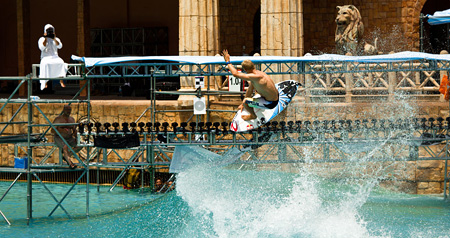NAB Show Eyes ‘What’s Next’
LAS VEGAS—Tucked away in one corner of the LVCC’s North Hall at the NAB Show’s International Research Park last month was a cluster of more than a dozen exhibitors who each had a common goal: devising what comes next in electronic media.
The most eye-popping of these maybe-someday displays at the IRP was the world’s only glasses-free 200-inch 3D screen—featuring sometimes dazzling, sometimes dizzying images boasting a “sweet spot” of nearly 10 feet diagonally. That’s the good news. The not-so-good news is it requires the deployment of scores of precisely calibrated digital projectors to work right. The expensive prototype is the pride and joy of Japan’s National Institute for Information & Communications Technology (NICT).

NAB Show attendees check out NICT’s 200-inch glasses-free 3D display at the International Research Park. “As you view the autostereoscopic display, it comes to you from 200 different perspectives from 200 HD projectors,” Dr. Shoichiro Iwasawa told TV Technology at the NAB Show through an interpreter. “If you move from side to side while watching it, you can see the different angles of the image changing what you see. Each of the 200 simultaneously projected images is 1080p/60 fps,” said Iwasawa, a key researcher at the Ultra-realistic Video Systems Laboratory at Japan’s Universal Communication Research Institute.
“The images appear to move as we move because the display is presenting different images to different locations. To achieve a natural stereoscopic effect, we play multi-view images with slight changes in the horizontal direction, so that the images switch smoothly as the viewer moves laterally,” Iwasawa said.
Since the NICT project is a large projector-based display, Iwasawa said some day it could be suitable for sports venues, live concerts and other special events in public settings. “For the moment it is still very much at the prototype stage when it comes to any form of [consumer] use,” he said.
A NEW ‘ANGLE’ ON 3D
Taking a different perspective on 3D (quite literally) is Communications Research Centre Canada, which used the IRP to show off an experimental curved 3D display designed to better enhance a viewer’s sense of presence and engagement.
“We’re trying to create a more immersive sense of 3D by using a curvilinear screen rather than a standard flat screen,” said Research Technologist Ron Renaud of the CRC’s Advanced Video Systems Group. “When something pops up in [regular 3D], it hangs out there in space… hovering. It’s not grounded, and that’s not the way it is in real life. But by using a curved display, that same object pops out of the screen—but also pops up—so by popping out and up it looks a lot more real.”
While acknowledging any curvilinear screen 3D scheme at this stage would not be practical for in-home use since virtually all HD content is 2D, Renaud said the shape of the screen (curving outward from the bottom toward the viewer) is extremely specific.
“It’s based on the same curve of distance whereby a human looking down toward the ground has the same exact range where it’s easiest to fuse two images together—a left and a right image—as we do in the real world. And the top of the image is for objects that are further away and the bottom is for closer-in objects, which is also how we view things in real life,” said Renaud.

Still of Timeslice Films capturing its proprietary “Time Slice” effect at Malaysia’s Sunway Lagoon Wavepool using 52 Canon DSLRs, with the help of water sports outfitter Ripcurl. In addition to the small screen that was demo-ed in Las Vegas, Renaud’s group is also test-driving its curvilinear concept on a bigger 12x16-foot screen at its lab in Ottawa. “This much larger screen allows us to view people close to human size in 3D and it’s very close to holographic. Our approach definitely gets even better when both objects and people are closer to their natural sizes,” Renaud said.
CUTTING-EDGE PRODUCTION
Another IRP resident, London-based TimeSlice Films, showed off its growing catalog of cutting-edge production services for producers interested in incorporating unique visual effects into their content. Most recognizable was its widely used frozen-time effect (dubbed “Time Slice”) that’s been deployed for a lot of TV commercials where the camera tracks around objects as they remain frozen yet multidimensional. (Some of these tracking shots have frame rates up to 1,000 fps.)
Timeslice Films’ recent networking prowess (the business kind) almost reads like a marketing tool for the NAB Show itself. “It started here at NAB last year,” said CEO Callum Macmillan. “We were exhibiting at NAB, involving a new type of camera array—which is what we specialize in… camera arrays. So last year here we noticed another NAB exhibitor, GoPro cameras, shooting with stereoscopic 3D, which is exactly what we needed. So we then walked down to the GoPro Booth and told them about what we had done previously.”
Consequently, Macmillan said, “we did some collaborative engineering and that gave birth to the GoPro video array that we use today. So from NAB in April a year ago, we wound up last June on a small island in Fiji with [water sports outfitter] Ripcurl and built the world’s first portable underwater video camera array—going into the open ocean and doing our freeze frames and Time Slice effects in the water.”
For broadcasters, Timeslice Films is now unveiling its “live-to-air” camera array services, designed to offer TV networks another way to “enhance the story” with unique tracking shots of key sports plays and highlights from other types of live events.
Aerial photography, too, was up in the air at the NAB Show’s IRP—as drone-maker Turbo Ace of Orange, Calif., hovered above the exhibit area with its new 3-pound X830-S “quadcopter” and its larger (6 pound) eight-propeller X88-J Octocopter.
The professional video industry's #1 source for news, trends and product and tech information. Sign up below.
